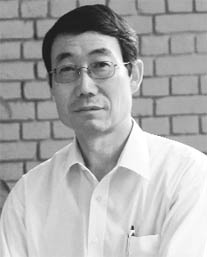|
first person The Tribune: April 12, 2009 Norio Okaguchi, the name may not sound even remotely Punjabi, but this Japanese national shares a deep bond with the land of five rivers. He is mesmerised by the literature and culture of Punjab. Dr Okaguchi, Professor and Head of Research Institute for Languages and Culture for Asia and Africa, Tokyo University of Foreign Studies, a lecturer of Hindi, swears by Punjabi.
He has already translated the legendary writer poet and theologian Bhai Vir Singh’s landmark Punjabi novel Sundari as well as Prof Harbans Singh’s articles on Sikh faith and philosophy of Guru Nanak Dev into Japanese. His love for Punjabi culture as well as literature has been growing in leaps and bounds. The writing prowess of stalwarts like Bhai Vir Singh, Kartar Singh Duggal and Kulwant Singh Virk impress him greatly. So overwhelming is his love for all things Punjabi that he has started taking extra interest in Hindi writers of Punjabi origin. "The land of Punjab", he asserts "is one of lokdhara, tradition and syncretism". Punjabi literature, he feels, is more emotive and more expressive in content than Japanese literature. He finds the spirit of openness of Punjabi culture endearing. He chose to translate Punjabi novel Sundari because "I found the character of its awe-inspiring heroine startling. I thought it would equally amaze Japanese readers who believe that Indian women are suppressed and subjugated". Talking about the trends in Japanese literature, he says, "Japanese Nobel laureates have focussed on Japanese tradition and culture and the need to preserve it". Seriously, are there readers for Indian literature in Japan? He reveals that the readership for Indian writing is confined to Buddhists. "Herein too," he shares, "they are more keen on Buddhist stories like the Jataka Tales". Interestingly, he is a Mahayana Buddhist who moved towards Hindi because of Buddhism. Co-author of Saral Hindi Vartalaap, translator of a dozen odd stories by writers of eminence like Bhisham Sahni, Yashpal, and Nirmal Verma, he holds, "Each language is unique and its literature provides insight into a nation’s history, the lifestyle of people and their culture". The present crop of Hindi writers, however, leaves him cold. "Frankly, I am not keeping track of it either", says Norio. His first love at present is Punjabi and he intends to study Punjabi literature in depth and detail. Though he admires Punjabi poetry, too, he has no plans of translating it. This is because he believes that poetry is "an emotional flush and rather onerous to translate". Not that translating prose has been a cakewalk for him. He quips, "In translation you don’t simply tell a story, you have to project the writer’s point of view and his ideology. To retain the natural flow replete with the writer’s perspective, one has to understand the background of the writer as well as the backdrop in which a particular story has been set". He agrees that some of the best works are conceived in times of distress. That’s why he finds stories that encapsulate the trauma of India’s partition incredibly potent. On choosing Bhai Vir Singh’s writings for translation, he speaks like a true Indian, nay a Punjabi, " rab di chhah (that’s what God ordained)". However, commenting on the style of the man, who revived and renewed Punjabi literary tradition, he remarks, "A link between traditional Indian style of storytelling and contemporary way of writing, Bhai Vir Singh represented the best and spoke to his readers directly like a narrator." He is also toying with the idea of translating another of his novels, Satwant Kaur. Besides, Bhai Vir Singh’s younger brother Balbir Singh’s lyrical essays, too, are on his mind. Candidly, he confesses that he cannot read Punjabi fluently and has to take the help of a dictionary often to find the correct meaning. Probably, it was this impediment that has led him to another project. He, who has written Express Punjabi for the benefit of Japanese desirous of learning Punjabi, plans to bring out a 30,000-word Punjabi-Japanese dictionary. Already familiar with typical Punjabi terms like pind and purahauna, he has zeroed in on 80,000 words from which he will sieve the ones with inimitable Punjabi flavour. "Language", he insists, "can build bridges". Only he is keen on building a direct link between Punjabi and Japanese, with no interlocutors, please. Hail Punjabi-Japanese linguistic affiliation.
|
|||
